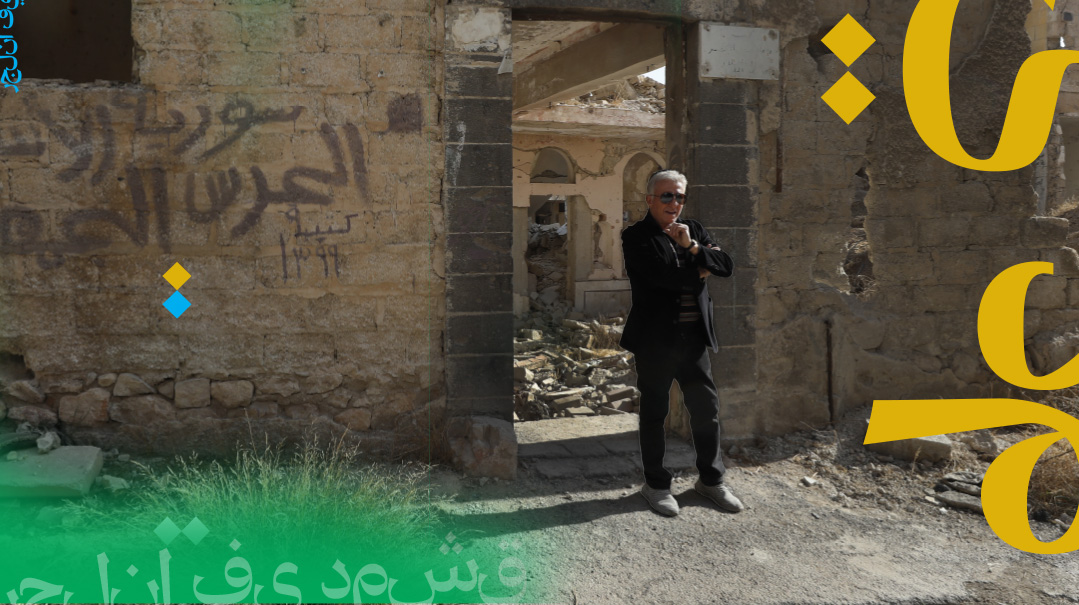Still in the Loupe
| August 15, 2023In Antwerp's diamond district, some frum stalwarts refuse to cut and run
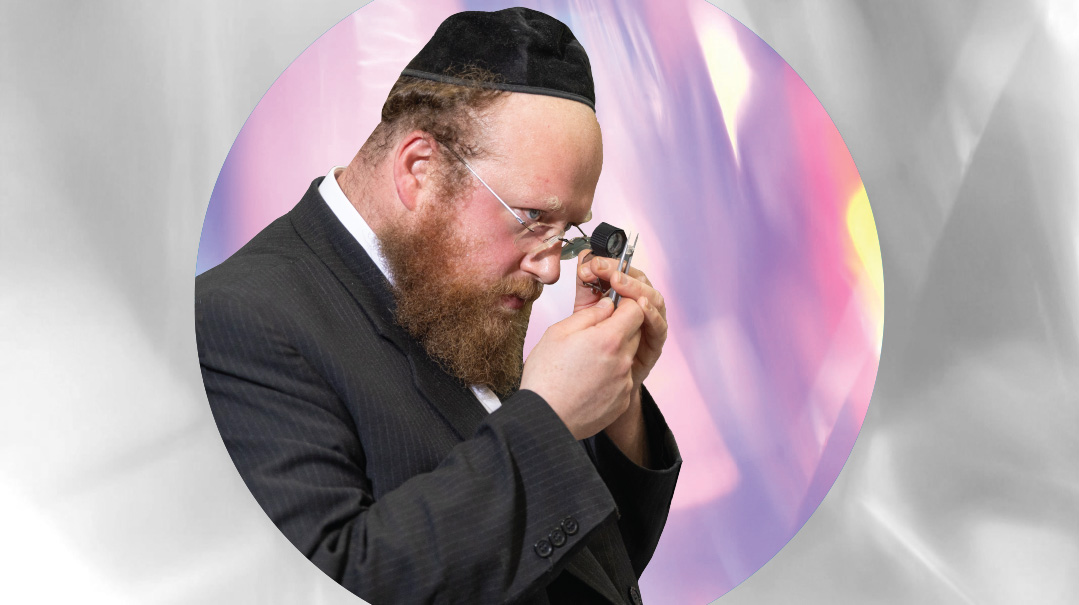
Photos: David Bernal photography, MB Goldstein
While the Belgian diamond bourse is still a great place to source a breathtaking and well-priced diamond for your next piece of jewelry (and you can make your purchase entirely in mamma loshen, too), the crown of “diamond capital of the world” that Antwerp has worn for hundreds of years has lost its sparkle.
At the heart of the Antwerp Diamantkwartier (Diamond Quarter), the bourse still maintains a dignified air of exclusivity and purpose, even if it’s no longer a bustling center of activity. Over the last 20 years, footfall from international traders in Antwerp’s diamond district is estimated to have fallen by about 80 percent, with Covid putting a further nail in the bourse’s coffin. For African and Indian businessmen selling rough diamonds, the Dubai diamond exchange has usurped the Belgian bourse, and the international diamond cutting and polishing industry has shifted from Antwerp to India because of lower labor costs.
Although Belgium is no longer the diamond center it once was and many in the frum community have moved on to other businesses, there are still some diehards who’ve continued to make parnassah in the diamond industry. These resilient merchants and craftsmen have adjusted to the changing realities, while retaining the vital trust factor they’ve long contributed to the industry and the heimish touch they’ve always brought to the trade.
On a visit to Antwerp’s now-subdued diamond bourse — as a man stands at the door of the Bethe Moshe Portuguese synagogue asking “Rabbosai, Minchah?” — we met with some of these stalwarts, who describe the skill, grit, business savvy and vision that still go into producing everyone’s favorite gemstone.
Like Mr. Mayer David, proprietor of I. David Diamond Tools right here on the Bourse square at Schupstraat 14.
“My father, Yissachar Dov David, was a war survivor who started a small business selling the equipment of his day, including manual scales with two pans for weights,” says Mr. David. But technology moves fast, and the Davids are still in the trade because they moved right along with it.
It’s easy to see how the evolution of machinery has cost jobs. Diamond cutting, or cleaving, was once a popular trade for frum Jews, as it could be done anywhere with just two cement-tipped sticks, a set of blades, and a good eye and skilled hand. Today, diamonds are cut by laser technology, so I. David doesn’t sell blades for cleaving anymore. Buki David, Mayer’s son, points to a machine that counts small diamonds. “In fifteen seconds, it counts one thousand stones. A person who used to do that job would have to count five times, to check he hadn’t made mistakes.”
Today’s scales, for example, are constantly being updated for precision. Buki shows us a late model with five zeros after the decimal point. “One gram equals five carat, so four zeros means it’s showing you one carat. This makes the biggest difference in small diamonds, because a stone of less than one carat has a completely different price. The naked eye can’t see the difference between 99 points and one carat, so without an accurate scale, a trader can overpay at least $1,000.”
The Davids manufacture loupes with Japanese lenses, as well as top-quality Belgian sieves to sift through tiny gemstones. Today they sell their products all over the world. “A guy came in and told us he’d been way out in the African jungle when he spotted a native African digging for diamonds. The African was using an I. David loupe.”
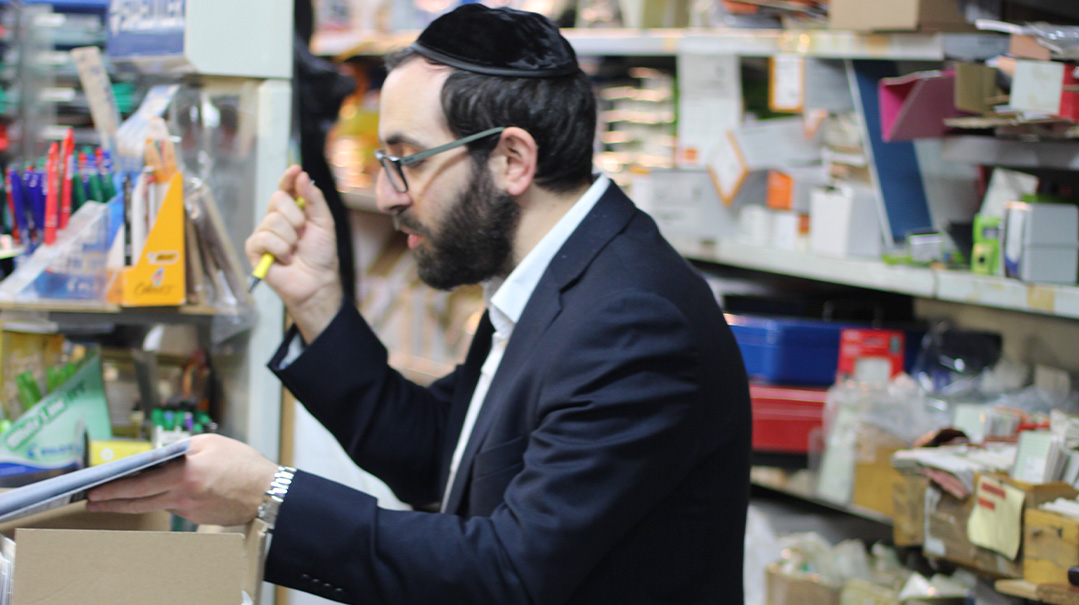
Passing by, you could confuse I. David for a stationary store instead of a treasure trove of diamond tools. Amid the clutter, Buki David makes sure clients around the world get the latest products
Staying Afloat
Passing by, you could confuse the front part of the business with a stationery store amid the assortment of papers, pens, and other paraphernalia. But a little further in, and the lamps and loupes take over. Buki David demonstrates the daylight lamps he sells, as diamonds need to be viewed under the correct light, 6,500 kelvin, in order to accurately check their color. Besides a bank account, I. David sells everything you’d need to get started in the trade: lamp, scale, loupe, tweezers, parcel paper, gauge, and a set of gemological instruments.
“Baruch Hashem, we had set up a website for our store long before Covid hit, because those who didn’t couldn’t survive. A lot of our business is online, shipping our merchandise. We have people reselling our products in India, the United States, Africa, Hong Kong, and Dubai. People used to think they had to see what they were buying, but Covid showed them otherwise,” Mr. David says.
Wringing hands in an emptying bourse wasn’t going to save anyone’s business; the only way to beat the migration of the industry was to join it. Antwerp businessmen who are still successful in diamonds today operate satellite offices in Dubai. For the past seven years, Buki David has traveled to Dubai regularly to exhibit and sell his diamond tools, even before the Abraham Accords made Dubai a venue for Jewish trade and tourism.
The feel of a family business is accentuated by the family pictures hanging on the office walls, together with professional certificates and a shelf of seforim. Two years ago, another son, Sruli, joined the business, too. But Mayer David says his own father, for whom the I. David business is named, never took any of that for granted.
Today Antwerp’s Jewish community is more diverse, but immediately after the war, Yissachar Dov David was one of only four Lithuanian Jews in a community of several thousand chassidish families. “My father came from Rav Elyashiv’s shtetl, Shavel,” Mr. David says. “The rest of the family and townspeople were burned alive in the beis medrash by the Nazis, but my father was learning in Telz at the time. He went through the lager, and in 1946 came to Belgium, alone in the world. A Yid saw him at the train station and took him in for a year and a half, during which time he learned the skill of cleaving, then went into the diamond trade.”
He fell in with an unscrupulous partner, though, and was ruined financially. But with grit, determination, and Heavenly help, he borrowed money and slowly built up a business selling tools for the diamond traders.
While online trade and international shipping are a forced part of Antwerp’s diamond trade, and the means through which his own company has survived the industry downturn, Mr. David points out that this bloats the costs and the figures and cuts into the ability to turn a profit.
“Often a customer requests to see some stones, and three companies ship goods at their own cost, when the customer is only going to buy from one of them,” he explains. “Or they send diamonds to the fairs and trade shows, paying for transportation and insurance, but don’t actually make big sales. Official Belgian figures may reckon this as import and export, but it doesn’t reflect a profitable business. While the shipping agents and insurers are doing well off it, the diamond dealers themselves might not be making money.”
In the diamond trade, accepting a vendor’s price at the outset is rare at best. “In the bourse, if someone accepts a price, he’s not a soicher,” Mr. David says. “The traders bring this attitude everywhere, and some of them can’t buy anything without handeling for a better deal.” His staff is used to customers negotiating and bargaining over their tools.
Up a narrow spiral staircase which seems to take up barely a square foot of the crowded shop floor, the storage loft features more tightly packed shelving. I’m fascinated by a bookcase which features rows of thick books, with titles like “The Diamond Bible” in several languages. Apparently, there’s a lot of inside knowledge about diamond-related origins, discoveries, and techniques through the ages. Buki David, who is fluent in six languages, has helped translate and edit one of the diamond bestsellers from Flemish into English (making sure to tread carefully with the references to evolutionary theories).
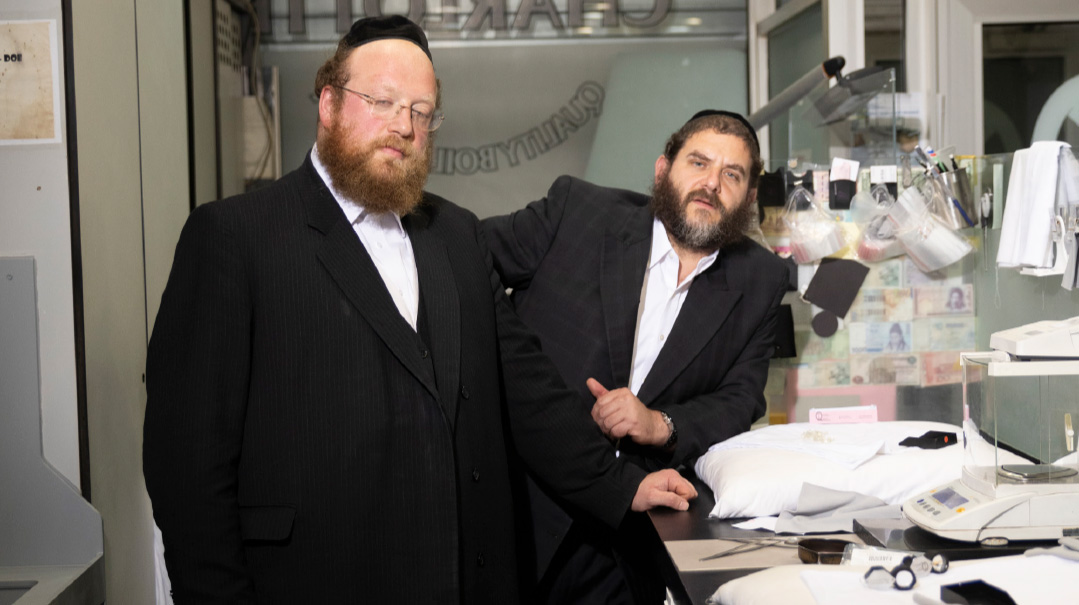
Mr. Mendy Eckstein and Mr. Shmuel Ollech found their niche in the diamond boiling business. “Baruch Hashem, people trust us. In diamonds, trust is everything”
The Real Thing?
One of the most complicated factors in the diamond industry are lab-grown diamonds, although these stones are every bit as dazzling and durable as their organic counterparts (as opposed to diamond simulants such as cubic zirconia which are made from synthetic crystals). Lab diamonds, like the “real thing,” are made of carbon crystals, but take between six and ten weeks to fully develop in a lab, as compared to organic diamonds that are formed when pockets of carbon are subjected to extremely high temperatures (over 2,000 degrees Fahrenheit) and pressures in the Earth’s mantle over time immemorial.
Within the frum community, there has been a recent movement to set lab-grown diamonds on the kallah’s jewelry and use the extra funds for the more practical purpose of setting up a home.
Although lab-grown stones are likely to lose value over the years as the market fills, these stones have identical beauty and physical qualities to those of natural diamonds. And even a long-time expert with his best diamond loupe cannot tell whether a stone is organic or lab-grown.
For that, they are buying the “Sherlock Holmes” detector produced by the Israeli Yehuda Diamond Company, which tells you in ten seconds whether the stone you are holding is natural or lab-grown. It’s a hot item, and with ever-quicker production methods coming out of India, “if you fall in, you can lose up to 90 percent of the value of your purchase,” Mr. David says.
Brokers use this machine to verify the status of their stones. Mistakes are costly, especially since if a buyer finds that the goods he bought were misrepresented, he loses trust in the broker and will take his business elsewhere.
The Sherlock Holmes machine today sells for about $7,000, and every dealer needs to double-check that no fake or manufactured stones are coming into the system. Still, personal expertise is never obsolete, because the machine alone is not foolproof — it is delicate and a hard knock can ruin its sensors.
Mr. David tells of one customer who was going to do business in London and borrowed two of these small machines from the company to check his gems. He came back ashen. “These machines saved me so much money!” he told David. “The stones were fakes, and I’ve been in touch with the police about these rogue dealers.” When he brought a few of the fake rough stones into Mr. David’s store to show him, David asked another veteran customer to estimate their worth. “He took out his loupe and looked, then said easily, ‘this is two or three thousand dollars per karat….”
When it comes to “young diamonds,” though, the machine will classify them as diamonds, while a practiced diamond dealer will know to stay away. These are stones that have been mined before their time and are too soft — their polish will turn to powder, and a novice who invests in them can lose his capital.
Another longtime technological game-changer is the Yehuda company colorimeter, a machine that can assess a rough diamond and reveal what color it will be when polished. This $35,000 aid is an unassuming portable machine that lets buyers know the worth of the rough stones they’re about to purchase.
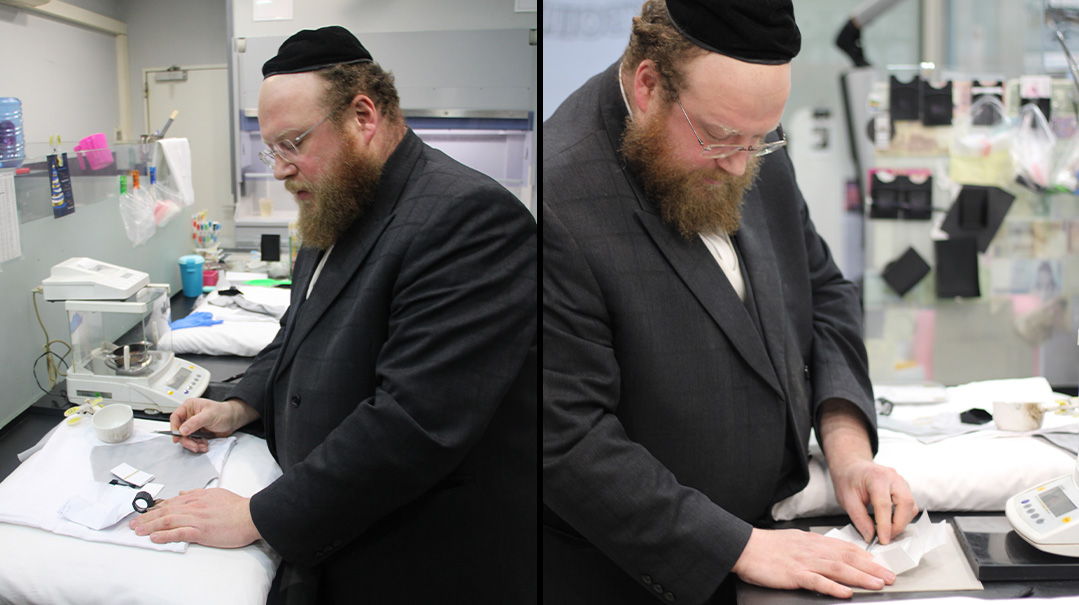
The cleaning enhances the value of the diamond by up to 20 percent, but that’s not enough to keep the business afloat. Mr. Eckstein and his partner have offices in Dubai, too
What It Boils Down To
Mr. Mendy Eckstein and Mr. Shmuel Ollech are partners in the limping diamond trade who found their niche in the diamond boiling business. These chassidish craftsmen, who operate in a storefront on the square, learned the trade right here, at the International Gemological Institute (IGI) in the bourse. They completed courses on working with both rough and polished stones and intended to become brokers or traders, but as the local industry contracted, they found their niche in the boiling business.
Since gems get polished — usually in India nowadays — while cemented to a diamond polishing tang, boiling removes any traces of that cement so the diamond can be valued and certified. Mr. Eckstein and Mr. Ollech also boil tiny gemstones, 1/1000 carat, to bring out their maximum luster before they are set in rings and watches, although they can’t share which brand-name diamond watch companies they deal with.
Mr. Eckstein buzzes us into the store, but in order to get behind the counter and examine the process, we have to go out again so that he can take us inside the building’s main entrance and past another security check.
“No goods are kept here overnight,” he emphasizes. “Customers come in the morning with their goods, which we list in our ledger, and pick up their cleaned stones by evening. Baruch Hashem, people trust us. In diamonds, trust is everything.”
Once a day, they prepare their special chemical solution in which the diamonds will be boiled. Closing the glass screen so we won’t inhale the fumes, and donning gloves and safety gear, they bring the stones to boil in special ceramic pots. After the stones have been left to cool, they’re rinsed several times with water, once with alcohol, then dried with a soft cloth.
City regulations insist that the water used to rinse the diamonds has to be purified after use, and the exhaust vent runs 24/7 in the shop, taking the fumes up eleven floors to the roof.
Mr. Eckstein shows us a packet of melee diamonds. “These small stones have been sifted through a metal sifter, so they’ve lost some of their vibrance, and boiling will bring it back,” he explains. “Sometimes dealers come in because they want the stones to be cleaned before shipping them to buyers, or after they have passed through many hands, or after a piece of jewelry is brought for repair.”
Part of the process involves meticulous tracking. “If someone gives us 93 stones, we need to number each one and work in order, so they don’t get mixed up.”
In a separate location nearby, Ollech and Eckstein work with the rough diamonds. Entering feels like going into a high-security chemical warfare lab. Well, not quite, because there is no warfare, but the room is well-sealed, with a powerful and noisy exhaust system, and the strong chemicals make full safety gear and acid-proof gloves a necessity.
Here, big packets of rough diamonds arrive straight from the mines in Africa, Brazil, or Russia (or from private diamond dealers), mixed with dirt and worthless young diamonds. Many are red, having become completely oxidized. In this room, each batch is placed into a custom-made, steel-coated canister lined with special metals. A cocktail of three strong chemicals is added, and the canisters are placed into an industrial oven, which is triple-locked and doubles as a safe. The diamonds will be left there overnight, so that the chemicals and heat can cleanse them fully. With 11 years of experience, Eckstein says that he has developed tailor-made boiling processes for the different stones’ origin and type.
“Our cleaning enhances their value by ten or even 20 percent,” Mr. Eckstein says. The bigger mining companies, like De Beers, have their own boiling department, but most dealers outsource this part of the process.
Intriguing as the world of rough diamonds is, it’s a relief to leave the room where apparently the fumes are so toxic that even the alarm system gets attacked by rust and has to be regularly replaced.
Mr. Eckstein lives just two blocks away, at the beginning of the Jewish district that nearly abuts the Diamond Quarter. He says he’s fortunate to have such a local business, but like the others who have remained in this glittering industry, he and his partner have offices in Dubai, too, for those diamonds that no longer make their way to Antwerp.
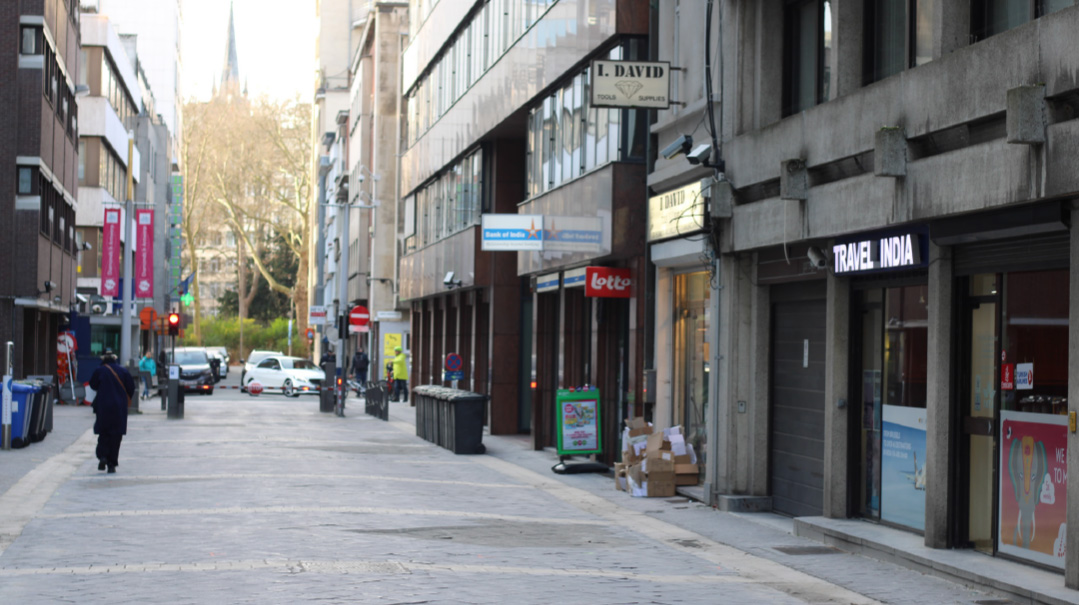
There are few chassidim on the Diamantkwartier these days, but a few of the stalwarts are still hanging on
Making the Cut
Passing security to get into the Diamond Plaza office building, we make our way upstairs to a workroom where we’ll see how rough diamonds are shaped into the beautiful, gleaming, cut stones that every woman loves.
While a diamond cleaver used to have to make a judgment call to shape a stone to its best advantage and value, today computer programs take away the guesswork — and the art. Our host, another member of Antwerp’s community, shows us the Israeli technology he uses. The safe is opened, and with nimble fingers, he shakes a couple of rough stones out of their wrapping paper and puts one in place to demonstrate.
“You used to have to use chemicals, or delicately make a ‘window’ to see inside the stone and assess how to cleave it, which carried some risk of damage. This Galaxy program creates a file on each diamond, taking into account its measurements, angles, and facets, and then shows you the different possibilities for shaping it: princess cut, cushion, oval, marquis, or emerald. A round cut is the most classic, and the most expensive.”
After deciding the best way to cut the diamond, another machine marks the stone with a laser, then it is placed on a wheel to be cut, which, in this company, is still done by hand. We inspect the room of industrial tables with the metal wheels, diamond blades dusted with diamond powder — because only diamond can cut diamond.
Lab-grown diamonds have the same impurities as natural stones and need to be cut and polished, too, but there are some diamond companies that won’t work on them on principle. Our host is happy to, although he tells us that these stones will probably lose much of their value as more of them flood the market.
When working on a stone, there is always the possibility of damaging it. Reb Wolf Ollech, a respected community member and veteran of the industry, relates an incident from his younger years, back when 20,000 people in Antwerp worked in the diamond trade and hundreds of Yidden made a living as cleavers, or “schleifers” in Yiddish.
“I was a young schleifer, working on a fifty-carat stone,” he says. “It was a problematic one, with a small crack. In order to decide on a cut, I made a window, cutting off some skin so I could see through a piece I knew would come off anyway… and the stone split in two! A fifty-carat stone. It felt like Tishah B’Av. The value of two smaller diamonds is much less. But in the end, we actually made two beautiful stones, and the crack had shown us the best way to design it, so it all worked out.”
Once the stone is cut and ready, it will find its way to the main buildings of the bourse, where marble-topped counters, ornate lobbies, and luxury offices host the deals of the diamantaires. To enter the trading floor, one has to hold a paid membership of the bourse or be a member’s guest. Our bags and our ID are checked before we’re allowed to take a quick look around. Jews had been so prominent in the bourse that all deals were sealed with the phrase, “Mazel U’brachah.” Today, the president of the bourse is Jewish diamantaire David Gottlieb.
Mr. Ollech says that many families are now giving lab-grown stones to a kallah, but the custom of giving natural diamonds is still alive and well. “They are exactly the same for all intents and purposes, except that one is man-made,” he explains. “The difference in value is because it’s not a natural, organic product. In the future, many more companies will jump on the manufacturing process, and the number of lab-grown diamonds they can produce will be unlimited, which will further lower the price. Each family to its own means and philosophy. Giving a lab-grown diamond is still a gift of something beautiful, stunning, and gorgeous, while the natural gem is a genuinely valuable asset.”
Mr. Ollech admits that he had a hard time when he first came into the diamond business, surrounded by such opulence. His father encouraged him to learn shleifering to make a living, and he learned the skill in a shleiferei in the Jerusalem neighborhood of Mekor Baruch. (Israel’s diamond trade developed during World War II when the Nazis occupied Europe’s diamond hubs, and remains a significant part of Israel’s economy.) Once Wolf Ollech started work, his new life felt dissatisfying.
“I felt I had stepped into a very mercenary, gashmiyusdig world, where everything revolves around money and diamonds, where the old-time diamantaires wore an air of superiority and exclusivity. It really bothered me,” he remembers. “With time though, I started to enjoy the creativity of my job. In those days, you had to sit for hours, using your skill and imagination to bring the best out of each diamond. It was only later when I came to peace in a deeper way with the fact that I was spending my days with diamonds. Today I view diamonds as a creation of the Ribbono shel Olam to bring love and good feelings to the world. Yes, He wants people to feel closeness and love, and our diamonds are part of those moments.”
(Originally featured in Mishpacha, Issue 974)
Oops! We could not locate your form.

